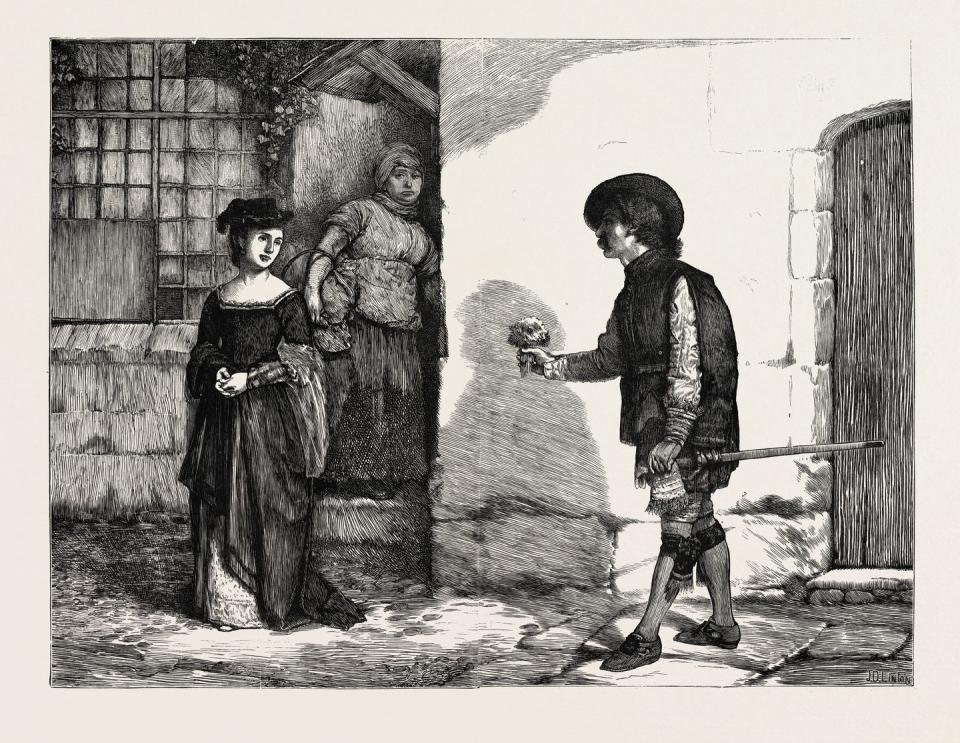What's the Origin of Valentine's Day? Like Your Bestie's Relationship Status, It's Complicated

If origin of Valentine’s Day were a Facebook relationship status, it would read, It’s complicated. Sure, today the meaning of Valentine's Day is entrenched in love and romance, bringing to mind boxes of chocolate, bouquets of flowers, romantic dinners, and heart-eye emojis. And for kids, it’s all about those creative Valentine’s Day boxes for collecting cards and heart-shaped treats at school. But when you delve into the history of the holiday we celebrate on February 14… well, things get a little murky, dark, and decidedly not for the faint of heart.
If you have ever wondered who created Valentine's Day, is Valentine's Day a pagan holiday, or who was St. Valentine, anyway?—you’re not alone, and as it turns out, even historians find themselves arguing the exact details. However, we can outline some basic Valentine’s Day facts, plus a few legends, about its origins, from ancient Rome to the Middle Ages to the modern-day Valentine’s Day we all know and love… or not, because gift-shopping for your valentine can be tough.

Where does the name Valentine come from?
The day is named, of course, for St. Valentine—we all know that by now. But why? Who is this mysterious Valentine?
According to The New York Times, it's possible that the holiday is based on a combination of two men. There were, after all, two Valentines executed on February 14 (albeit in different years) by Roman Emperor Claudius II in the 3rd century A.C.E., reports NPR. It's believed that the Catholic Church may have established St. Valentine's Day in order to honor these men, who they believed to be martyrs.
It's possible that one of these men, Saint Valentine of Terni, had been secretly officiating weddings for Roman soldiers against the emperor's wishes, making him, in some eyes, a proponent of love.
Another story involves the practice of writing love letters to your valentine. It's said that St. Valentine wrote the first “valentine” greeting to a young girl he tutored and fell in love with while he was imprisoned for the crimes outlined above. According to The History Channel, before his death, he wrote her a letter signed “From your Valentine," which remains a commonly used phrase to this day.
But these romantic anecdotes are only legends. So little historical information is known about the martyrs named St. Valentine that in 1969 the Roman Catholic Church removed the feast day from its calendar, though St. Valentine is still recognized as a saint.

Does Valentine's Day have pagan origins?
There was a mid-February fertility festival in ancient Roman called Lupercalia (and the rest of this paragraph is not PG). Dedicated to the Roman god of agriculture, Faunas, and Roman founders Romulus and Remus, this feast of debauchery involved a ritual where an order of Roman priests ran naked through the streets, "gently slapping" women with the blood-soaked hides of sacrificed animals (yes, really), which they believed promoted fertility. Later, notes Britannica.com, the women would be paired off with men "by lottery."
In the late 5th century A.C.E., Pope Gelasius I outlawed Lupercalia. Some sources contend that he designated the celebration of St. Valentine's Day on February 14 to replace the pagan holiday.
When did Valentine's Day become a romantic holiday?
If you're thinking that none of this sounds very lovey-dovey, that's because Valentine's Day did not begin to resemble the romantic holiday we know today until the Middle Ages—and we might have the poet Geoffrey Chaucer to thank.
Through research, the late scholar Jack B. Oruch, a University of Kansas English professor, determined that Chaucer linked love with St. Valentine for the first time in his 14th-century works "The Parliament of Fowls" and "The Complaint of Mars," notes the Times. Therefore, Oruch claimed that Chaucer invented Valentine's Day as we know it today.
At the time of Chaucer's writing, February 14 also happened to be considered the first day of spring in Britain, because it was the beginning of birds' mating season—perfectly appropriate for a celebration of affection. In fact, Chaucer's "The Parliament of Fowls" is all about birds pairing off: "For this was on Saint Valentine’s day, / When every fowl comes there his mate to take," reads one of the verses.
Why didn't Chaucer just write "For this was on February 14…"? Poetry aside, it would not have been the convention of the times. In a blog post for The Folklore Society, Jacqueline Simpson explains it this way: "In the Catholic Church every day in the year celebrates at least one saint, and for a public who had no printed calendars it was easier to remember dates by names than by figures." Thus, the connection between the martyr St. Valentine and the romantic holiday we celebrate might be in name only.

Why do we celebrate Valentine's Day?
Whether or not Chaucer can be fully credited, it is true that he and fellow writer Shakespeare popularized the amorous associations surrounding the day. Soon, people began penning and exchanging love letters to celebrate Valentine's Day.
The mid-19th century marked the beginning of many of the commercialized Valentine's Day traditions we know today. Victorian men wooed women with flowers, Richard Cadbury created the first heart-shaped box of chocolates, and the New England Confectionery Company, or Necco, began stamping out an early version of Conversation Hearts. Also around this time, the "Mother of the American Valentine" Esther Howland, only in her early 20s, popularized store-bought English-style valentines in America thanks to her innovative assembly line process that made the elaborate cards affordable. (Google some of Howland's creations—they will inspire you to DIY your own Valentine's Day cards!)
By the early 1910s, an American company that would one day become Hallmark began distributing its more official "Valentine's Day cards." The rest, of course, is history.

What part does Cupid play on Valentine's Day?
It's not all about St. Valentine! Cupid—that winged baby boy often seen on Valentine's Day cards and paraphernalia—is another symbol of this love-filled holiday, and it's easy to understand why. In Roman mythology, Cupid was the son of Venus, goddess of love and beauty. He was known for shooting arrows at both gods and humans, causing them to fall instantly in love with one another. While it's unclear exactly when Cupid was brought into the Valentine's Day story, it's certainly clear why.
You Might Also Like

 Yahoo Movies
Yahoo Movies 
